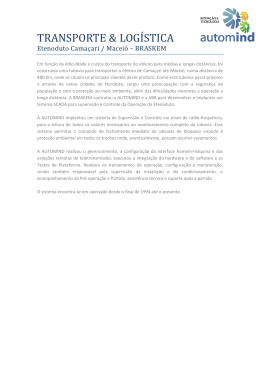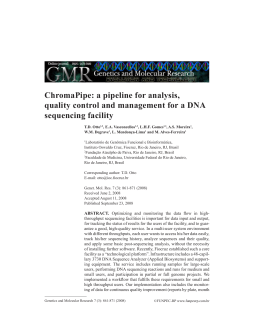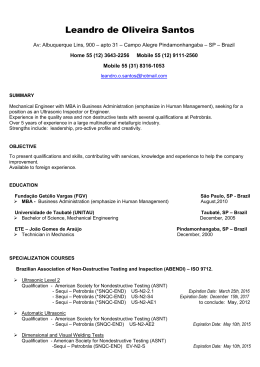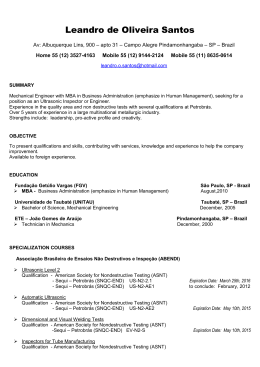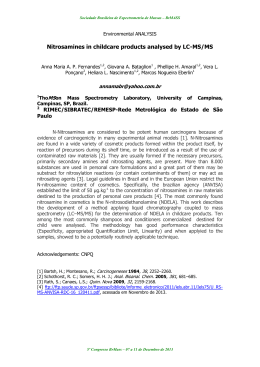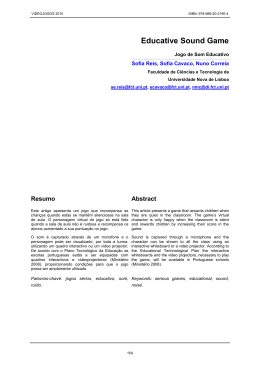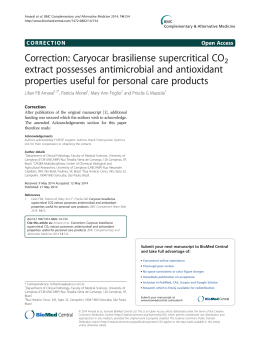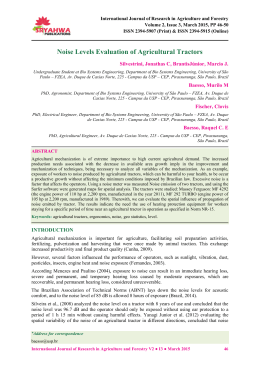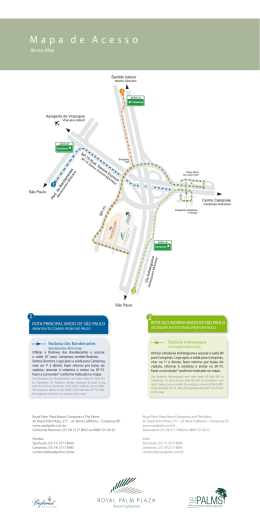4o PDPETRO, Campinas, SP 21-24 de Outubro de 2007 3.1.0179-1 - 1 LEAK DETECTION IN PIPELINES. PRESSURE TRANSIENT AND SOUND ANALYSES Elisangela O. Sousa 1 (UNICAMP), Sandra L. Cruz 2 (UNICAMP), João A. F. R. Pereira 3 (UNICAMP) 1 DESQ / FEQ/ UNICAMP, 13.083-970, Campinas, , SP, Brazil, , [email protected] DESQ / FEQ/ UNICAMP, 13.083-970, Campinas, , SP, Brazil, [email protected] 2 Pipeline networks are essential parts of the infrastructure of modern society. They frequently cross highly populated regions, water supplies or natural reserves. Sudden pressure changes, bad maintenance, corrosion and weld failure could lead to leaks and even small leaks can give rise to events with considerable economic impact, environmental damage, injuries and fatalities, which could be avoided through careful pipeline supervision and appropriate pumping shutdown. Therefore leak detection and location methods play a key role in the overall integrity management of a pipeline system. This work presents the development and test of a gas leak detection technique in pipelines based on acoustic method. A microphone has been developed in order to catch the noise generated by leak occurrence in a pipeline operating with and without continuous flow of gas (air). The experimental work was carried out in a 60 m long, ½” in diameter pipeline. The microphone and also a pressure transducer were installed in the pipeline and connected to a PC computer through an ADA converter. An electric circuit was developed to process the noise generated by the leakage. This noise was captured by the microphone and sent to a signal processing circuit that had two different stages. On the first stage the signal was only amplified and on the second one, the signal was filtered through three band pass filters, centered in 1 kHz, 5 kHz and 9 kHz each one, generating three continuous signals in different frequencies. Pressure and noise data were obtained on-line, and a program, written in C language, was developed to read and process all data. The operational pressure varied from 1 kgf/cm² to 7 kgf/cm². Leakages of several magnitudes were simulated through an orifice installed in pipeline whose diameter varied from 0.1 mm to 5.0 mm. The experimental results showed that it is possible to detect leaks in pipelines based on acoustic method. In the cases of leak occurrence during continuous gas flow the presence of the microphone is decisive for leak detection, since the changes in pressure observed through the pressure transducer may be negligible depending on the gas flow rate. The analysis of the signal amplitude for different frequencies shows that the leakage noise signal changes with both leak magnitude and pipeline pressure. The developed technique shows to be a very reliable tool for safety supervision of pipelines. Pipeline Networks, Leak Detection, Acoustic Method. 1. INTRODUCTION Pipeline networks are an essential part of the infrastructure of modern society. They frequently cross highly populated regions, water supplies or natural reserves. Sudden pressure changes, bad maintenance, corrosion and weld failure could lead to leaks. A small percentage loss can give rise to events with considerable economic impact, environmental damage, injuries and fatalities, which could be avoided through careful pipeline supervision and appropriate pumping shutdown. Therefore leak detection and location methods play a key role in the overall integrity management of a pipeline system and considering that many techniques have been proposed for leak detection in pipelines (Black, 1992). Silva et al (1996) reported the detection and location of leaks in a 1250 m long pipeline. The detection was based on the analysis of pressure transients through on-line computer techniques. Pressure transient profiles generated by leak occurrence presented a sudden drop in pressure, followed by a certain recovery, which depended on liquid flow rate and leak magnitude. Leaks small as 5 % of the nominal liquid flow were readily detected and located with an error smaller than 5 m. Fukushima et al. (2000) reported a leak detection system implemented in a 250 km Niigata-Sendai pipeline. The leak detection was performed by measuring pressure and temperature at the valve stations and by measuring flow rate of gas at the inlet and outlet. In their method, the mass balance is modelled along the pipeline. The leak detection system automatically determines a leaking point and its leaking rate in real-time basis. The minimum leakage rate that could be detected was 1.1 % and in order to estimate leak location it was 1.8 %. Recently, Taghvaei et al., (2006) showed that cepstrum analysis is a viable approach to leak detection and location in pipelines. The technique was based on the analysis of pressure waves through fluid-filled pipelines. Pressure transducer signals were filtered using discrete wavelets to remove the dc offset, and the low and high Copyrigth©2007 ABPG 3.1.0179-1 - 2 4o PDPETRO, Campinas, SP 21-24 de Outubro de 2007 frequencies and then they were analysed using a cepstrum method which identified the time delay between the initial wave and its reflections. In this work a leak detection technique based on the analysis of noise sound caused by leak occurrence has been tested in a pipeline transporting gas, with a microphone been developed and used to catch the noise sound. Macleod et al. (1991) presented a general review of the state of the art of acoustic monitoring by specific applications including the detection of high pressure fluid leaks from pipelines and storage facilities. The acoustic detection system can listen for the growth of detects in the containment and monitor for loss of process fluid from any defects that penetrates the pressure boundary, or from any other leakage path such as valves or flanges. The frequency range is selected to be the optimum choice between background plant noise, which tends to decrease with rising frequency, and acoustic attenuation, which increases with frequency. 2. EXPERIMENTAL WORK In this work, the characteristics of pressure transients and sound noise generated by leak occurrence in a 60 m long pipeline were analyzed during pipeline operation with and without continuous gas flow. The pipeline consisted of a bunch of ½" in diameter, 6m long galvanized iron tubes joined by 90o elbows. Figure 1 shows the experimental assembly used to simulate the occurrence of leaks in the pipeline. Figure 1. Gas pipeline experimental assembly. Leaks were provoked manually through an on / off valve installed in a side outlet at the entrance of the pipeline. The leak magnitude was controlled through an orifice installed in the leak line. The orifice size was varied from 0.4 mm to 5.0 mm in diameter. Air was used in the experiments been provided by the compressor which feed the air line of faculty laboratories and was fed to the pipeline through a 37.5 l liters pressure vessel. Air pressure was varied in the ranged from 1.0 kgf/cm2 to 7.0 kgf/cm2. In the leakage experiments with steady state gas flow a 0.8 mm orifice was installed at the end of the pipeline to keep it pressurized. Leaks were simulated experimentally for various operation conditions of gas pressure and leak magnitude. In this work pipeline monitoring was made through a microphone and a pressure transducer installed in the pressure vessel, both connected to a PC computer through an ADA converter. The microphone was developed in the laboratory to catch the noise sound caused by leak occurrence. The noise signal was sent to a signal processing circuit where it was amplified and filtered through three band pass filters, each one centered in 1 kHz, 5 kHz and 9 kHz, generating three continuous signals in different frequencies. The PC computer was a Pentium 233 MHz, 500 MB, 16 MB RAM. Pressure and noise data were obtained on-line and a software, written in C Language, was developed to read and process all data. 3. RESULTS AND ANALYSIS 3.1. Leak detection without continuous flow of gas. Figure 2 shows the pressure transients and the changes in signal amplitude which have been generated by leakage in the pipeline operating without continuous flow of gas. With the equipment set at the required pressure, leak was provoked and the experiment lasted until the system was completely empty. With leak occurrence the amplitude of the noise generated by the leak decreased with pipeline pressure. Pressure and sound noise amplitude profiles in Figure 2 are those caused by gas leakage through orifices of 1.0 mm and 5.0 mm in diameter, when the pipeline had initial pressures (P0) of 4.0 kgf/cm2 and 7.0 kgf/cm2. The amplitude of the generated noise increased as the orifice size increased. Copyrigth©2007 ABPG 4o PDPETRO, Campinas, SP 21-24 de Outubro de 2007 3.1.0179-1 - 3 For the same initial pressure of 7.0 kgf/cm2, the amplitude of the noise generated when emptying the pipeline through a 1.0 mm orifice was not higher than 4.0 V, while that when the orifice is 2.0 mm reached 4.75 V. The obtained results showed that leak occurrence is clearly detected through both pressure and signal amplitude changes. The noise signal amplitude increased and the pressure dropped, both suddenly, and then decreased until the system was empty of air. For orifices larger than 2.5 mm the dominant frequency was 1 kHz indicating a low sound, and for smaller orifices the dominant frequency was 9 kHz. Figure 2. Pressure transients and sound amplitude (operation without continuous flow). Copyrigth©2007 ABPG 4o PDPETRO, Campinas, SP 21-24 de Outubro de 2007 3.1.0179-1 - 4 3.2. Leak detection with continuous flow of gas. Figure 3 shows the pressure transients and the sound noise amplitude variations caused by leak occurrence when the pipeline operated with steady state flow gas. The profiles in Figure 3 are those for orifices of 1.0 mm, 2.0 mm and 5.0 mm in diameter with the pipeline operating under constant pressure of 4.0 kgf/cm2 and 6.0kgf/cm2. Figure 3. Pressure transients and sound amplitude (operation with continuous flow). Copyrigth©2007 ABPG 4o PDPETRO, Campinas, SP 21-24 de Outubro de 2007 3.1.0179-1 - 5 The characteristics of pressure transient profiles depended on leak magnitude and on the initial system pressure. With orifices larger than 2.0 mm the pressure dropped suddenly and remained constant during leakage For the range of orifice sizes shown in Figure 3 the pressure transient profiles allowed leak detection, but that did not always happened, depending on the system pressure and as the orifice size was smaller than 1.0 mm. On the other hand leak occurrence was always detected through the noise sound amplitude variation and the dominant frequency was 5 kHz for most of the orifices used. The analysis of the sound amplitude showed that the characteristics of the noise caused by the leaks change with the orifice size and with the initial pressure of the pipeline. 4. CONCLUSIONS A leak detection technique based on the analysis of the noise generated by leak occurrence has been developed and tested to detect gas leaks in a 60 m long pipeline. The obtained results showed that it is possible to detect leaks in pipelines based on acoustic method. In the cases of leak occurrence during continuous gas flow the presence of the microphone was decisive for leak detection, since the changes in pressure measured through the pressure transducer may be negligible depending on the gas flow rate. The analysis of the signal amplitude for different frequencies showed that the leakage noise signal changes with both leak magnitude and pipeline pressure. The developed technique shows to be a very reliable tool for safety supervision of pipelines. 5. REFERENCES BLACK, P. State-of-the-art pipeline leak detection. Pipeline Systems. Dordrecht: Kluwer Academic Publishers, p. 287-298. 1992. FUKUSHIMA, K.; MAESHIMA, R.; KINOSHITA, A.; SHIRAISHI, H.; KOSHIJIMA, I. Gas pipeline leak detection system using the online simulation method. Computers and Chemical Engineering, v.24, p.453456, 2000. MACLEOD, I.D.; ROWLEY, R.; BEESLEY, M.J.; OLLEY, P. Acoustic monitoring techniques for structural integrity. Nuclear Engineering and Design, p.191-200, 1991 SILVA, R.A.; BUIATTI, C.M.; CRUZ, S.L.; PEREIRA, J.A.F.R. Pressure wave behaviour and leak detection in pipelines. Computers and Chemical Engineering, v.20, p.S491-S496, 1996. TAGHVAEI, M.; BECK, S.B.M.; STASZEWSKI, W.J. Leak detection in pipelines using cepstrum analysis. Meas, Sci. Technol, v.17, p.367-371, 2006 DETECÇÃO DE VAZAMENTOS EM TUBULAÇÕES. ANÁLISE DO TRANSIENTE DE PRESSÃO E DO RUÍDO SONORO. Redes de tubulações são partes essenciais da infra-estrutura da sociedade moderna. Frequentemente, elas atravessam regiões altamente povoadas, suprimentos de água ou reservas naturais. Variações bruscas de pressão, manutenção inadequada, corrosão e falha em soldas podem causar vazamentos e, mesmo vazamentos de pequenas proporções podem provocar eventos de considerável impacto econômico, danos ambientais, acidentes e fatalidades, os quais poderiam ser evitados através de supervisão cuidadosa da tubulação e parada apropriada do bombeamento. Deste modo, detecção e localização de vazamentos são peças fundamentais do gerenciamento de um sistema de tubulações. Este trabalho apresenta o desenvolvimento e teste de uma técnica para detecção de vazamentos de gás em tubulações, baseada em método acústico. Desenvolveu-se um microfone de modo a capturar o ruído sonoro gerado pela ocorrência de vazamento em uma tubulação operando com e sem fluxo contínuo de gás (ara). O trabalho experimental foi realizado em uma tubulação de ½ polegada de diâmetro e 60 metros de comprimento. O microfone e um transdutor de pressão foram instalados na tubulação e conectados a um microcomputador através de uma placa conversora ADA. Desenvolveu-se um circuito elétrico para processar o ruído gerado pelo vazamento. Este ruído foi capturado pelo microfone e enviado para um circuito processador de sinal com dois estágios diferentes. No primeiro estágio o sinal foi somente amplificado a no segundo, o sinal foi filtrado através de três filtros passa banda, centrados em 1 kHz, 5 kHz e 9 kHz cada, gerando três sinais contínuos com freqüências diferentes. Dados de pressão e ruído foram obtidos on-line e um programa em linguagem C foi desenvolvido para ler e processar todos os dados. A pressão de operação variou de 1 a 7 kgf/cm². Vazamentos de várias magnitudes foram simulados através de um orifício instalado na tubulação cujo diâmetro variou de 0,1 mm a 5,0 mm. Os resultados experimentais mostraram que é possível detectar vazamentos em tubulações baseado em método acústico. Nos casos de vazamentos durante fluxo contínuo de gás a presença do microfone foi decisiva para a detecção do vazamento, desde que as variações na pressão medidas através do transdutor de pressão nem sempre Copyrigth©2007 ABPG 4o PDPETRO, Campinas, SP 21-24 de Outubro de 2007 3.1.0179-1 - 6 foram significativas, dependendo da vazão do gás. A análise da amplitude do sinal para diferentes freqüências mostra que o sinal do ruído do vazamento varia com ambas magnitude do vazamento e pressão na tubulação. A técnica desenvolvida mostra-se uma ferramenta confiável para a supervisão segura de tubulações. Redes de Tubulações, Detecção de Vazamentos, Método Acústico. Os autores são os únicos responsáveis pelo conteúdo deste artigo. Copyrigth©2007 ABPG
Download
